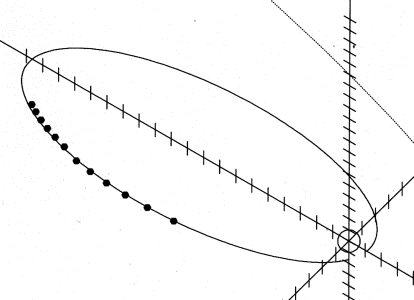The "Profile" Constellation Mission
Introduction

|
"Profile" is a proposed multi-spacecraft mission to the Earth's magnetosphere. The original plan called for 12 small spacecraft sharing the same elongated ellipse and following each other one hour apart (as drawn above). This was later modified to 2 groups of 6 satellites each, on two slightly different orbits: the groups alternately overtake, then spread out, then overtake again. Each of these two "formations" is useful in its own way (as are in-between groupings). For instance, when the formations overtake each other at apogee, a relatively compact "supercluster" is formed which can intensively cover a small region, e.g. the region in which a substorm begins. Because it is now believed that this is most likely to happen at a distance of 25 RE (Earth radii), the apogee distance, originally set at 20 RE, will probably be raised to that value. At other times the satellites are strung out along the ellipse, allowing near-radial profiles to be derived of magnetic fields, plasmas and convective flows, which is the reason for the mission´s proposed name. This also enables the mission to time earthward progress, of shocks and waves from the sunward side of Earth and of substorm phenomena from the tail. The science goals of "Profile" are quite extensive. When they were presented at the 1996 Fall AGU, an imaginary program was included, of AGU sessions five years in the future (i.e. in 2001) with solutions to specific problems, such as might arise from a "Profile" mission. Click here for that list, also listed as appendix to "Science Closure" of the "" Multiprobe Mission" below. The 1997 Fall Meeting of the AGU, held in San Francisco December 8-12, included a special session Science Closure and Enabling Technologies for Magnetospheric Constellation Missions At that session, a talk and a poster on "Profile" were presented by D.P. Stern:
Planning the "Profile" Multiprobe Mission Science Tasks for "Profile". A more up-to-date description of the "Profile" mission concept (including "Twin Profile") and of the way its orbits and science plan were planned is found in two articles (abstracts are linked):
|
|
Systematic Identification of Preferred Orbits for Magnetospheric Missions: 1. --- Single Satellites Journal of the Astronautical Sciences 49, 559-583, 2001 Systematic Identification of Preferred Orbits for Magnetospheric Missions: 2. The "Profile" Mission Journal of the Astronautical Sciences 50, 149-171, 2002
|
|
Back to the "Profile" Index Page
Back to the "Exploration" Index Page |
